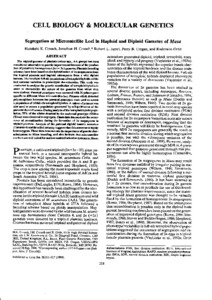| dc.contributor.author | Crouch, H.K. |
| dc.contributor.author | Crouch, J.H. |
| dc.contributor.author | Jarret, R.L. |
| dc.contributor.author | Cregan, P.B. |
| dc.contributor.author | Ortiz, R. |
| dc.date.accessioned | 2019-12-04T11:33:23Z |
| dc.date.available | 2019-12-04T11:33:23Z |
| dc.date.issued | 1998 |
| dc.identifier.citation | Crouch, H.K., Crouch, J.H., Jarret, R.L., Cregan, P.B. & Ortiz, R. (1998). Segregation at microsatellite loci in haploid and diploid gametes of musa. Crop Science, 38(1), 211-217. |
| dc.identifier.issn | 0011-183X |
| dc.identifier.uri | https://hdl.handle.net/20.500.12478/5655 |
| dc.description.abstract | The triploid genome of plantain (Musa spp., AA group) has been considered intractable to genetic improvement because of the production of putatively homogeneous 2n (= 3.r) gametes. Plantain breeding schemes have been based on the hybridization of 2n megaspores from the triploid plantain and haploid micr08pores from a wild diploid banana. The resultant full-sib populations of tetraploid hybrids exhibited extreme variation in phenotypic characteristics. This study was conducted to analyze the genetic constitution of tetraploid hybrids in order to characterize the nature of the gametes from which they were derived. Parental genotypes were screened with 31 primer pairs specific to different Musa microsatellite loci. Primers which detected polymorphisms between the parental genotypes were used to screen a population of 14 full-sib tetraploid hybrids. A subset of primers was also used to screen a population generated by self-pollination of the parental diploid banana. During analysis of the tetraploid hybrid population, 75% of the alleles donated by the maternal genotype (Obino I'Ewai) were observed to segregate. These data demonstrate the occurrence of recombination during the formation of 2n megaspores in triploid plantain. Analysis of the paternal diploid banana accession (Calcutta 4) and its selfed progeny suggests that this accession is highly heterozygous. These data demonstrate the importance of genetic characterization to Musa breeding, and also indicate that microsatellite markers are well suited for marker-assisted selection systems in Musa. |
| dc.language.iso | en |
| dc.subject | Plantains |
| dc.subject | Chromosomes |
| dc.subject | Plants |
| dc.subject | Bananas |
| dc.title | Segregation at microsatellite loci in haploid and diploid gametes of Musa |
| dc.type | Journal Article |
| dc.description.version | Peer Review |
| cg.contributor.affiliation | International Institute of Tropical Agriculture |
| cg.contributor.affiliation | United States Department of Agriculture |
| cg.coverage.region | Africa |
| cg.coverage.region | West Africa |
| cg.coverage.country | Nigeria |
| cg.isijournal | ISI Journal |
| cg.authorship.types | CGIAR and advanced research institute |
| cg.iitasubject | Plantain |
| cg.iitasubject | Plant Breeding |
| cg.iitasubject | Banana |
| cg.accessibilitystatus | Limited Access |
| local.dspaceid | 104935 |
| cg.identifier.doi | https://doi.org/10.2135/cropsci1998.0011183X003800010035x |

